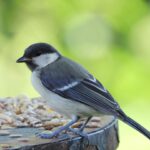When it comes to creating a sanctuary for our feathered friends, not all trees are created equal. Selecting the right types of trees can significantly enhance the attractiveness of your backyard for nesting birds, enhancing your enjoyment of nature, and fostering biodiversity in your micro-environment. But which trees are best for attracting an array of winged beauties?
Tree Choices
The variety of trees which call to our feathered friends are numerous, but some certainly outshine others in their allure. Let’s take a closer look at a few top contenders:
Oak Trees
Hosting over 500 bird species, the oak tree stands as an impressive host to a vast congregation of birds. The acorns produced by this tree serve as a tempting buffet for numerous bird species, making it a top attraction in any avian-friendly backyard.
Pine Trees
An important nesting spot for many bird species, pine trees offer the added advantage of abundant cone seeds which serve as a reliable food source. Pine trees, with their evergreen foliage, offer a year-round shelter for birds. Their variant height and wide branches offer nest sites for a myriad of bird species. Learn more about these bird-friendly trees here.
Cedar Trees
Cedars, with their luscious berries, are a beacon to cedar waxwings and other berry-loving birds. Besides the food offering, their dense foliage offers good cover and nesting spots for birds.
Birch Trees
Birch trees, especially those like the river birch, attract a large variety of nesting birds due to their seed-producing catkins. Their peeling bark also invites various insects which further attract insectivorous birds.
Importance of Native Trees
While the afore-mentioned trees are great, it’s vital to note that native trees often hold higher relevance to local bird species. These trees have coevolved with local bird species and cater specifically to their nesting and food requirements. Planting native trees thus contributes positively to bird diversity, survival rates, and overall health.
When it comes to incorporating native trees into your backyard, this resource is an excellent guide.
Creating Better Habitats
Just as in real estate, diversity is key when it comes to attracting a variety of birds. Providing an array of tree species increases the chances of catering to the needs of more bird species. To further improve the attractiveness of your trees, you could consider adding a diversity of shrubs and understories. These lower plant layers provide great cover and make your yard even more appealing to a broader range of bird species.
Lastly, let’s not forget the importance of dead trees. While they may not seem aesthetically pleasing, dead trees, also known as snags, are important for cavity-nesting species. So, perhaps consider leaving a few around for the sake of your bird friends. They’ll definitely appreciate it!
Trees and Climate Change
Trees do much more than just provide a home for birds. They play a crucial role in reducing the impact of climate change by absorbing carbon dioxide, one of the primary greenhouse gases. As climate change affects bird species by altering their habitats and food availability, planting more trees can provide resilience to these changes. Find more information on how trees create a halo of resilience for bird species by visiting this web page.
Conclusion
In conclusion, providing the right trees for nesting birds is more than just a hobby – it’s a crucial component of protecting and preserving our natural environment. We have the ability to create sanctuaries right in our backyards, helping to support a diverse array of bird species while also addressing bigger environmental issues like climate change. It’s an activity that brings with it not only the joy of supporting bird life but also the satisfaction of knowing you are making a positive difference in the world.



